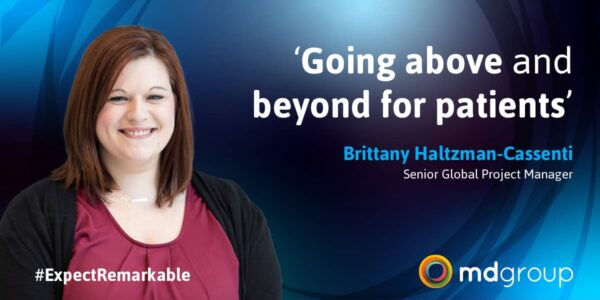
Through the mdtalk podcast and video series, we’re on a mission to highlight the most important issues impacting clinical research, the patient experience and the future of healthcare.
Listen to the episode here or search for mdtalk wherever you get your podcasts.
Episode summary
Research suggests 40% of clinical trial participants drop out of clinical trials before the study is complete. Furthermore, failure to recruit and retain patients in a clinical study can cost between $600,000 and $8 million per day.
With 80% of study sites currently failing to meet their enrolment targets, how will the move towards hybrid clinical studies make a difference? And what barriers do we still need to overcome to ensure hybrid trials become the norm?
In Episode 10 of mdtalk, host LaQuinta Jernigan (mdgroup’s Chief Operating Officer) is joined by Caroline Jackson, mdgroup’s Executive Vice President of Patient Services to discuss the pros and cons of hybrid clinical studies and explore how we can work to make clinical trials more accessible, cost-efficient and patient-focused.
Key takeaways
1. Hybrid clinical trial designs are truly patient-centric because they give patients choice
To demonstrate a truly patient-centric approach to research, we need to support sites to reduce any burden on patients, and deliver a positive patient experience that leads to retention.
Hybrid clinical trials help patients participate, whilst ensuring data is collected in the most appropriate way and critical endpoints for the study are met. In some cases, patients will be required to visit a site, but this doesn’t mean other components of the study can’t be decentralised to reduce the burden of involvement.
There’s a lot of exciting talk about decentralisation and a focus on remote participation, but this doesn’t necessarily put patients’ needs at the forefront, because it doesn’t give them choices.
We need to educate sites, patients, sponsors and CROs – all the key players in the industry – to bring hybrid solutions into the definition of decentralisation.
2. Hybrid clinical trials bridge the gap between willingness to participate and realising participation
In the US around 5% of adult patients participate in clinical trials – and that’s even lower in minority groups.
There’s very good evidence that people feel positive about clinical research, but there’s a huge gap between willingness to participate and actual participation. Hybrid studies can bridge that gap by making a wider variety of studies accessible.
Leveraging technologies such as telemedicine reduces clinic time, giving sites more time to recruit new patients and better support existing participants remotely. What’s more, these sites end up with more motivated patients who are more likely to stay in the study. As a result, studies get completed faster and sometimes at a much lower cost.
3. We need education, communication and collaboration to overcome the reluctance to embrace hybrid approaches
We work in a highly regulated industry, but guidelines and regulations haven’t yet been updated to reflect the significant changes to clinical trial conduct in recent years.
Understandably, many sponsors are unwilling to take risks in an uncertain environment, especially amidst concerns that local laws will prohibit certain activities such as direct-to-patient shipments of investigational products. Even telehealth is prohibited in some countries.
Additionally, hybrid approaches might require changes to organisational infrastructure. Sponsors and sites need to have the right people, processes and systems in place to be able to manage hybrid trials successfully.
In some cases, there’s still doubt as to whether patients need or want this kind of support. While this may have been the case years ago, with the rise of social media and other outlets, patients have a voice and regularly communicate with each other. They know what can be done to support them – and so they expect it.
To overcome barriers to adopting hybrid solutions, education, communication and collaboration are key.
We need to be having early discussions with the sponsors writing the protocols, speaking to sites about treatment options available to patients and introducing these from the start – not adding them in as a last resort or contingency. That’s when we’ll see the real benefit of these solutions.
4. Technology is essential but it can’t replace the human-to-human connection patients need
While technology plays a critical role in enabling hybrid clinical trials, patient service elements are equally important.
A survey by The Center for Information and Study on Clinical Research Participation (CISCRP) found the majority of patients found features like questionnaires, text messages and video calls helpful in the course of their trials. However a third of patients surveyed said having to use technology, such as smartphones or tablets, actually disrupted their day.
This demonstrates how important it is to find the right balance, ensuring technologies are deployed appropriately and in conjunction with other patient-related services. For example, it’s no good giving patients a link to an app and saying you’ll speak to them in four weeks. That’s not going to keep patients engaged – there must be an ongoing dialogue to establish a relationship.
Technology is vital, but it’s not a fix-all solution. And it certainly can’t replace the human-to-human connection that’s vital for hybrid studies to be a success.
Want more from us?
For more content discussing the most important issues in clinical trials, patients and the future of medical research, follow us on Twitter and LinkedIn – and sign up for our monthly newsletter.
To find out more about how we facilitate remarkable experiences at every stage of the clinical journey, visit our services page.



